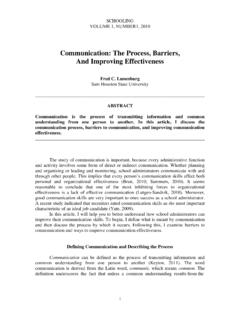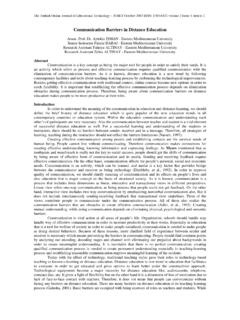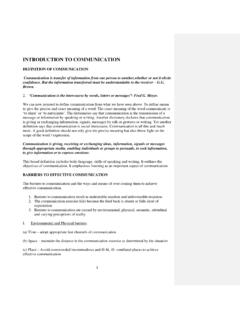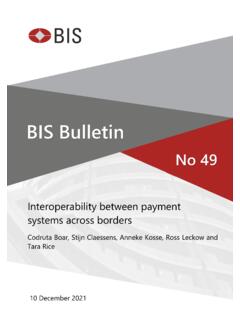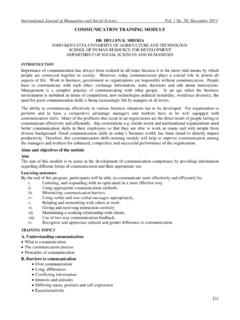Transcription of Data Management Capability Assessment Model (DCAM)
1 Enterprise Data Management Council 2014 Data Management Capability Assessment Model (DCAM) Working Draft Version July 30, 2014 Developed by Enterprise Data Management Council 2014 Published: July 30, 2014 EDM Council WORKING DRAFT Version This Data Management Capability Model ( Model ) is being provided to you ( Recipient ) solely for peer review purposes. All materials are the proprietary property of EDM Council, Inc. ( EDM Council ) and all rights, titles and interests are vested therein. The Model , or any portion thereof, may not be distributed, copied or made available for the use of any other party without the prior written authorization of EDM Council.
2 In addition, the Model , or any portion thereof, may not be used in any way by Recipient, its officers, employees or agents or by any other party without the prior written consent of EDM Council. By reviewing the Model , or any portion thereof, the Recipient (and each person reviewing the Model ) agrees to the terms set forth above. 2014 EDM Council, Inc. All Rights Reserved. Enterprise Data Management Council 2014 Page 1 INTRODUCTION The Data Management Capability Model (DCAM) was created by the Enterprise Data Management Council based on the practical experiences and hard won lessons of many of the world s leading organizations.
3 It is a synthesis of best practices associated with the Management of data content across the horizon of interconnected processes. The Data Management Capability Model defines the scope of capabilities required to establish, enable and sustain a mature data Management discipline. It addresses the strategies, organizational structures, technology and operational best practices needed to successfully drive data Management . It addresses the tenets of data Management based on an understanding of business value combined with the reality of operational implementation. To manage data in today s organizational environment starts by recognizing that proper data Management is about managing data as meaning.
4 This is a relatively new concept for many organizations. It is not easy to articulate and not very well understood. Data exists everywhere within an organization and must be managed consistently within a well-defined control framework. The DCAM helps identify this framework by defining the capabilities required to make data Management a critical part of a firms everyday operational fabric. The challenges of properly managing data are significant. There are many legacy repositories and a plethora of functions to unravel. There are social and political barriers to overcome. There are real IT challenges and execution gaps to address.
5 Data ownership and accountability are hard to implement. Funding is often project based. And many firms simply don t have the strong executive support that is needed to ensure that the organization stays the course in the face of short term measurement criteria, operational disruption and conflicting stakeholder challenges to properly address the realities of the data Management challenge. We understand this reality because we ve been there and we have the scars across our back to prove it. Data is foundational. It is the lifeblood of the organization. The bad data tax is a significant expenditure for many firms.
6 Unraveling silos and harmonizing data is the prerequisite for eliminating redundancy, reducing reconciliation and automating business processes. Managing data is essential if we are to gain insight from analytics, feed our models with confidence, enhance our service to clients and capitalize on new (but often fleeting) business opportunities. DCAM provides the guidance needed to assess current state, and provide the objectives of target state, for your data program. The DCAM is organized into eight core components. 1. The Data Management Strategy discusses the elements of a sound data strategy, why it is important and how the organization needs to be organized to implement.
7 2. The Data Management Business Case and Funding Model addresses the creation of the business case, its accompanying funding Model and the importance of engaging senior executives and key stakeholders for approval. 3. The Data Management Program discusses what s organizationally needed to stand up a sustainable Data Management Program. 4. Data Governance defines the operating Model and the importance of policies, procedures and standards as the mechanism for alignment among (and compliance by) stakeholders. 5. Data Architecture focuses on the core concepts of data meaning how data is defined, Enterprise Data Management Council 2014 Page 2 described and related.
8 6. Technology Architecture focuses on the relationship of data with the physical IT infrastructure needed for operational deployment. 7. Data Quality refers to the concept of fit-for-purpose data and the processes associated with the establishment of both data control and data supply chain Management . 8. Data Operations defines the data lifecycle process and how data content Management is integrated into the overall organizational ecosystem. Each component is preceded with a definition of what it is, why it is important and how it relates to the overall data Management process. These are written for business and operational executives so as to demystify the data Management process.
9 The components are structured into 35 capabilities and 109 sub-capabilities. These capabilities and sub-capabilities are the essence of the DCAM. They define the goals of data Management at a practical level and establish the operational requirements that are needed for sustainable data Management . And finally, each sub- Capability has an associated set of measurement criteria to be used in the evaluation of your data Management journey. Welcome to the world of data Management . The EDM Council is indebted to the dozens of members who have contributed to the development of the Data Management Capability Model .
10 We are always searching for ways to enhance and improve the Model . We encourage your feedback. We are interested in your rants, raves and alternative points of view. For more information on the DCAM and on the EDM Council, please contact us at Michael Atkin John Bottega Managing Director Executive Advisor EDM Council EDM Council Enterprise Data Management Council 2014 Page 3 Contents FOREWARD .. 4 DATA Management STRATEGY .. 7 THE DATA Management BUSINESS CASE AND FUNDING Model .. 13 DATA Management PROGRAM .. 17 DATA GOVERNANCE.
